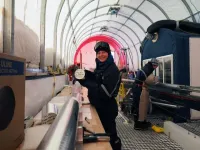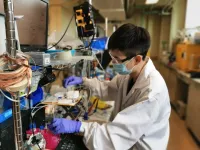(Press-News.org) The South Pole and the rest of East Antarctica is cold now and was even more frigid during the most recent ice age around 20,000 years ago -- but not quite as cold as previously believed.
University of Washington glaciologists are co-authors on two papers that analyzed Antarctic ice cores to understand the continent's air temperatures during the most recent glacial period. The results help understand how the region behaves during a major climate transition.
In one paper, an international team of researchers, including three at the UW, analyzed seven ice cores from across West and East Antarctica. The results published June 3 in Science show warmer ice age temperatures in the eastern part of the continent.
The team included authors from the U.S., Japan, the U.K., France, Switzerland, Denmark, Italy, South Korea and Russia.
"The international collaboration was critical to answering this question because it involved so many different measurements and methods from ice cores all across Antarctica," said second author T.J. Fudge, a UW assistant research professor of Earth and space sciences.
Antarctica, the coldest place on Earth today, was even colder during the last ice age. For decades, the leading science suggested ice age temperatures in Antarctica were on average as much as 9 degrees Celsius cooler than the modern era. By comparison, temperatures globally at that time averaged 5 to 6 degrees cooler than today.
Previous work showed that West Antarctica was as cold as 11 degrees C below current temperatures. The new paper in Science shows that temperatures at some locations in East Antarctica were only 4 to 5 degrees cooler, about half previous estimates.
"This is the first conclusive and consistent answer we have for all of Antarctica," said lead author Christo Buizert, an assistant professor at Oregon State University. "The surprising finding is that the amount of cooling is very different depending on where you are in Antarctica. This pattern of cooling is likely due to changes in the ice sheet elevation that happened between the ice age and today."
The findings are important because they better match results of global climate models, supporting the models' ability to reproduce major shifts in the Earth's climate.
Another paper, accepted in June in the Journal of Geophysical Research: Atmospheres and led by the UW, focuses on data from the recently completed South Pole ice core, which finished drilling in 2016. The Science paper also incorporates these results.
"With its distinct high and dry climate, East Antarctica was certainty colder than West Antarctica, but the key question was: How much did the temperature change in each region as the climate warmed?" said lead author Emma Kahle, who recently completed a UW doctorate in Earth and space sciences.
That paper, focusing on the South Pole ice core, found that ice age temperatures at the southern pole, near the Antarctic continental divide, were about 6.7 degree Celsius colder than today. The Science paper finds that across East Antarctica, ice age temperatures were on average 6.1 degrees Celsius colder than today, showing that the South Pole is representative of the region.
"Both studies show much warmer temperatures for East Antarctica during the last ice age than previous work -- the most recent 'textbook' number was 9 degrees Celsius colder than present," said Eric Steig, a UW professor of Earth and space sciences who is a co-author on both papers. "This is important because climate models tend to get warmer temperatures, so the data and models are now in better agreement."
"The findings agree well with climate model results for that time period, and thus strengthen our confidence in the ability of models to simulate Earth's climate," Kahle said.
Previous studies used water molecules contained in the layers of ice, which essentially act like a thermometer, to reconstruct past temperatures. But this method needs independent calibration against other techniques.
The new papers employ two techniques that provide the necessary calibration. The first method, borehole thermometry, takes temperatures at various depths inside the hole left by the ice drill, measuring changes through the thickness of the ice sheet. The Antarctic ice sheet is so thick that it keeps a memory of earlier, colder ice age temperatures that can be measured and reconstructed, Fudge said.
The second method examines the properties of the snowpack as it builds up and slowly transforms into ice. In East Antarctica, the snowpack can range from 50 to 120 meters (165 to 400 feet) thick, including snow from thousands of years which gradually compacts in a process that is very sensitive to the temperature.
"As we drill more Antarctic ice cores and do more research, the picture of past environmental change comes into sharper focus, which helps us better understand the whole of Earth's climate system," Fudge said.
INFORMATION:
Fudge, Steig and Kahle are among 40 authors on the Science paper. Other co-authors on the JGR: Atmospheres paper are Michelle Koutnik, Andrew Schauer, C. Max Stevens, Howard Conway and Edwin Waddington at the UW; Tyler Jones, Valerie Morris, Bruce Vaughn and James White at the University of Colorado, Boulder; and Buizert and Jenna Epifanio at Oregon State University.
Both papers were supported by the U.S. National Science Foundation. Both papers made use of the South Pole ice core, a project that in 2016 completed a 1.75 kilometer (1.09 mile) deep ice core at the South Pole. That project was funded by the NSF and co-led by Steig and Fudge with colleagues at the University of California, Irvine, and the University of New Hampshire.
For more information, contact Fudge at tjfudge@uw.edu, Kahle at eckahle@uw.edu and Steig at steig@uw.edu.
Part of this article were adapted from an OSU press release.
Scientists have gained the best view yet of the brightest explosions in the universe: A specialised observatory in Namibia has recorded the most energetic radiation and longest gamma-ray afterglow of a so-called gamma-ray burst (GRB) to date. The observations with the High Energy Stereoscopic System (H.E.S.S.) challenge the established idea of how gamma-rays are produced in these colossal stellar explosions which are the birth cries of black holes, as the international team reports in the journal Science.
"Gamma-ray bursts are bright X-ray and gamma-ray flashes observed in the sky, emitted by distant extragalactic sources," explains DESY scientist Sylvia Zhu, one of the authors of the ...
The biggest shark attack in history did not involve humans.
A new study by Earth scientists from Yale and the College of the Atlantic has turned up a massive die-off of sharks roughly 19 million years ago. It came at a period in history when there were more than 10 times more sharks patrolling the world's oceans than there are today.
For now, researchers don't know the cause of the shark die-off.
"We happened upon this extinction almost by accident," said Elizabeth Sibert, a Hutchinson postdoctoral associate in Yale's Department of Earth and Planetary Sciences and ...
Scientists have developed the first cells that can construct artificial polymers from building blocks that are not found in nature, by following instructions the researchers encoded in their genes.
The study, led by scientists from the Medical Research Council (MRC) Laboratory of Molecular Biology, in Cambridge, UK, also found the synthetic genome made the bacteria entirely resistant to infection by viruses.
The scientists say their research could lead to the development of new polymers - large molecules made of many repeating units, such as proteins, plastics, and many drugs including antibiotics - and make it easier to ...
Hydrogels are polymer materials made mostly from water. They can be used in a wide range of medical and other applications. However, previous incarnations of the materials suffered from repeated mechanical stress and would easily become deformed. A novel crystal that can reversibly form and deform, allows hydrogels to rapidly recover from mechanical stress. This opens up the use of such biocompatible materials in the field of artificial joints and ligaments.
Many of us suffer the occasional sports injury or experience some kind of pain relating to joints and ligaments at some point in our lives. ...
Researchers from University of Toronto Engineering have developed an improved electrochemical system that raises the value of captured CO2 by converting more of it into valuable products than ever before.
The International Energy Agency recently cited carbon capture and storage as one of the strategies that can help keep global emissions low enough to limit global warming to 1.5 C by 2050. But captured carbon currently has little economic value, reducing the incentive for companies to invest in this technology.
A University of Toronto Engineering team led by Professor Ted Sargent is addressing this challenge by designing advanced electrolyzers that use electricity to convert captured CO2 into the petrochemical building blocks of common everyday materials, ...
An engineering researcher from the University of Sydney, in collaboration with a team at the University of Toronto, has developed an electrochemical system that coverts a greater amount of CO2 into valuable products.
The International Energy Agency recently cited carbon capture and storage as a strategy that can help keep global emissions low enough to limit global warming to 1.5°C by 2050. However, captured carbon currently has little economic value, reducing the incentive for companies to invest in this technology.
The team of researchers has addressed this challenge by designing advanced electrolysers - machines using electricity to convert captured CO2, plus water, into the building blocks of common everyday materials, ...
Astronomers have measured very-high-energy gamma rays coming from the aftermath of a gamma ray burst - an enormously energetic explosion of a star in another galaxy. The results shine light on these immensely powerful but little-understood cosmic events, and challenge standard models of how gamma ray bursts radiate light during their afterglow phases. As a dying massive star enters its final death throes, its core begins to collapse, and then explodes as a supernova. Some types of supernovae generate jets of particles moving at close to the speed of light; if the jet is pointed directly towards Earth it can be observed as a burst of gamma ray radiation that lasts several seconds. These gamma ray bursts are sometimes ...
The widespread non-pharmaceutical interventions implemented to mitigate the transmission of COVID-19 have led to drastic reductions in the annual circulation patterns of other endemic respiratory viruses, including influenza and the common cold. How this will affect future transmission patterns of these pathogens remains unknown. In a Perspective, Gabriela Gomez and colleagues discuss what could be expected concerning the epidemiology of common respiratory viruses once the COVID-19 pandemic subsides and argue that expanded genomic and clinical surveillance is needed to best understand the spread of respiratory viruses in a post-COVID-19 world. "Currently, the emergency response to COVID-19 is a global priority, but preparation for future threats ...
Nineteen million years ago, sharks nearly disappeared from Earth's oceans, according to a new study, which provides evidence for a previously unknown mass ocean extinction event. Sharks as a species never recovered from this, the study's authors say; their diversity today represents only a fraction of what it once was, the data suggest. Much of what is known about ancient ocean ecosystems is derived from rock and fossil records, which are generally limited to shallow-water deposits and provide only a small glimpse into the ocean-wide history of marine ...
By engineering the genetic code of a synthetic strain of E. coli to include several nonstandard amino acids, researchers rendered the synthetic bacterium virtually invincible to viral infection. Their work is some of the first to design proteins using not one but multiple non-canonical amino acids. "The ability to generate designer proteins using multiple non-natural building blocks will unlock countless applications, from the development of new classes of biotherapeutics to biomaterials with innovative properties," write Delila Jewel and Abhishek Chatterjee in a related Perspective. In nature, biological systems use 64 codons - a unique triplet of nucleotides - to encode ...


